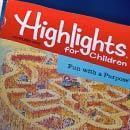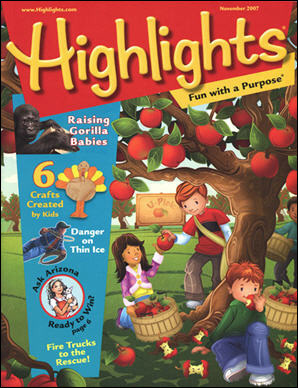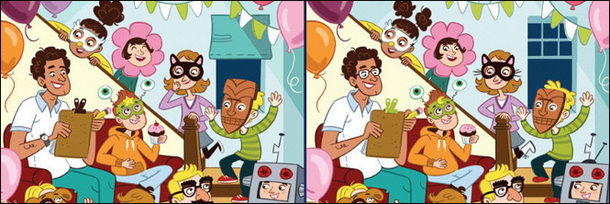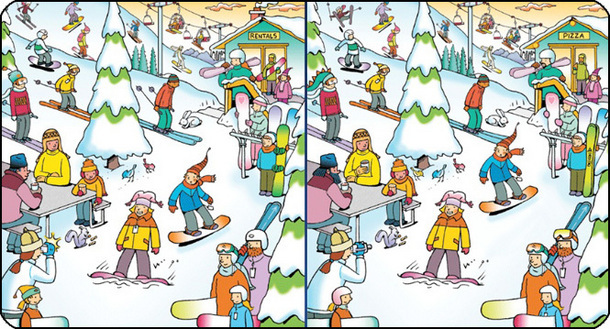The 5 Depressing Lessons We Learned from Highlights Magazine

Children are like sponges. They soak up everything from languages and mathematics to bacterial infections. And just like sponges, it all festers inside them until they are culture-laden stinky creatures, eager to spread whatever they've absorbed in the form of color wheels, multiplication tables and occasionally some pink eye. Sometimes, however, children will accidentally absorb wisdom they can't process or apply, a heartbreaking wisdom that no one should be saddled with until they are adults. I'm guessing kids today learn these lessons from the lawless, unforgiving world of the Internet, but when I was a child, we learned them from Highlights magazine.

Most people already associate Highlights with anxiety, given that the magazine only seems to exist in the waiting rooms of doctors and dentists. But some of us actually had subscriptions as children, our parents erroneously believing that they were helping to shape our minds with puzzles and word jumbles, oblivious to the heart-wrenching truths we were too young to articulate but old enough to feel. I can't say for certain whether most of what Highlights taught me was intentional, but with a slogan like "Fun With a Purpose," I have a hard time believing they did anything that wasn't deliberate. Here are the five most sobering truths Highlights magazine ever taught me.
Goofus and Gallant

Lesson: Some People Will Be Terrible Forever
In nearly every issue of Highlights magazine since 1948, Goofus and Gallant have instructed kids on the rules of common courtesy. Gallant has always exemplified the cornerstones of social etiquette, while Goofus has remained a shockingly unrepentant dick for over 60 years. Highlights created the characters to illustrate both the right and the wrong way to interact with the rest of humanity, but the fact that they use the same two characters to make their point every time indirectly teaches a secondary lesson as well: Yes, manners are always important, but there are also plenty of kids and adults out there who will just never fucking get it.

Highlights taught us that we will inevitably encounter people who are just permanently despicable (they are easy to spot, thanks to their ruffled hair). No amount of arguing, pleading or logic will ever make them better human beings because they lack the capacity to understand anything other than self-interest. Goofuses will never understand why they're terrible, and so they will go on being terrible forever. Worst of all, if the comic is any indication, they will live parallel lives to the Gallants, enjoying all the same opportunities throughout their lifetime with no foreseeable consequences for being awful.

Highlights is essentially asking us to be kind despite the fact that impulsive, mean people will be leading the same lives as us minus all of the social responsibilities. Even for adults, that's a tough pill to swallow.
Double Check, aka Spot the Differences

Lesson: Your Mind Will Betray You
Double Check offers two nearly identical pictures and asks the reader to find all the differences between them. It encourages kids to approach everything with a critical eye and to focus on the details, regardless of how small or inconsequential they may seem. But whoever has been in charge of creating these brainteasers for the past few decades has grossly overestimated the sleuthing abilities of 7-year-olds. On the Highlights Kids website, you can test your ability by identifying all 24 discrepancies in a picture like the one below in under two minutes. I will warn you, should you try it now even as an adult, you will undoubtedly fail.

The true lesson of Double Check isn't in honing your awareness until you find all of the differences in the pictures; it's in hunting for the final two or three differences and never seeing them, ever. The puzzle teaches us the unnerving lesson that we will never be able to fully trust our own brains. It's called inattentional blindness, and the game is just a cruel exploitation of an affliction from which we all suffer. Cracked has mentioned it before, but the abbreviated version is that we are so overloaded with visual input every day that our brain only chooses to pay attention to the small percentage it considers relevant, and then guesses at the rest. As a result, we can miss clowns riding on unicycles right in front of us, we can be in mid-conversation with strangers and not realize that they've switched genders or we can spend hours looking at two illustrations of a ski mountain without realizing that the girl holding a snowboard is wearing gloves in one picture and mittens in the other (you're welcome). Ultimately, brains are designed to lose at the Double Check game, which gives kids everywhere their first taste of what it feels like to be betrayed by their own minds.
Guess the Object

Lesson: When You Look too Closely at Anything, It Will Stop Making Sense
On the surface, Guess the Object is as simple as looking at an up-close photo of something common and trying to figure out what it is. But the deeper message is one most kids won't understand until years later when they get high for the first time and repeat a single word until it loses all meaning. Guess the Object always made me very uneasy as a child because it defied a logic I had always relied on: The closer you examine something, the better you're supposed to understand it. Instead, the game forces you to see alien worlds in hairbrushes and black holes in the tips of ballpoint pens.

The game is teaching kids that focusing too hard on even an ordinary object can ruin their understanding of it. What's worse, no one is really sure how to determine when focus starts becoming detrimental; we have no metric for that. We're all just sort of guessing our entire lives at how to continue seeing the forest through the trees, and for a kid that's a terrifying insight.
What's Wrong With This Picture?

Lesson: Your Sense of Wrong Is Probably Wrong
Much like Where's Waldo? Highlights offers a scene of absurdity in What's Wrong? and then asks the reader to identify all the out-of-place objects, which, it turns out, is pretty much everything. But identifying the problems in the game is a slippery slope, since it's all pandemonium to begin with. Here's an example from the website:

Sure, that picture is littered with crazy: Rainstorms only happen under umbrellas, penguins go to birthday parties alone and people still own boomboxes. But there are also just as many elements that are unintentionally crazy and no one seems to care. Why does everyone only have three fingers? Who would put uncovered food next to a live chicken? Why, with all these kids in capes, is no one shoving them to the ground?!

As an 8-year-old, I was bewildered that these weren't acceptable answers, and then privately embarrassed that I didn't actually know what qualified as strange. Given that there's zero context for normalcy in the game, the tacit lesson of What's Wrong? seems to be that "wrong" doesn't mean the same thing across the board. Wrong as a concept is nebulous, with varying degrees, and according to Highlights, some of them do and don't count. That's a dangerous lesson to offer kids, particularly kids who have access to uncovered food and a chicken and are feeling reckless about maintaining a healthy distance between the two.

Lesson: It's Always More Fun to Laugh at Someone's Mistakes Than With Their Jokes
Granted, word searches aren't specific to Highlights magazine, but they're important to this list because each one is like a tiny dose of schizophrenia for children; in addition to all the intentional words buried in the matrix of letters, there's also several words that just happen together by accident, like tiny messages hidden in the errors of some randomizing computer. And if a child is very lucky, it's a dirty message. As a boy, the first thing I did with any word search was ignore all the words in the key, and instead I hunted for accidental swear words. Here is a list of my crowning achievements:
DICK
TIT
PEEN
SEXBUT
BUTASS
The last two don't technically qualify as words, but they were such incredible finds that I still remember them to this day. Also, because my sense of humor hasn't changed a bit. As a kid, I relished in the thought that somehow these mistakes slipped past everyone in charge of Highlights but not me. The word searches made me laugh harder in each issue of Highlights than any other section of the magazine, which is a shame, because Highlights had an entire Jokes section.
And therein lies the sobering lesson.
The jokes in the magazine have always been abysmal, even for their target demographic. The poor authors of Highlights are forced to be as broad and as clean as possible, pumping out crippled, milquetoast punch lines that are more likely to make children furious than to make them laugh. Here's an example from the most recent Highlights magazine:
"Knock knock."
"Who's there?"
"Repeat."
"Repeat who?"
"Who, who, who, who ..."

Meanwhile, the word search a few pages away is bringing down the house. The inadvertent lesson there is that sometimes it can be a lot funnier to laugh at someone than with them. It's understandably a tough realization, given that everyone will end up on the wrong end of that scenario. Still, as a child, it all seemed kind of worth it, with accidental nuggets like "BUTASS" cropping up every few issues.
You can follow Soren on Twitter, or you can let him win your heart on Tumblr.
For more from Soren, check out 5 Mediocre Movies Made Awesome by Real Events and 4 Flawed Life Lessons Movies Accidentally Taught Us.